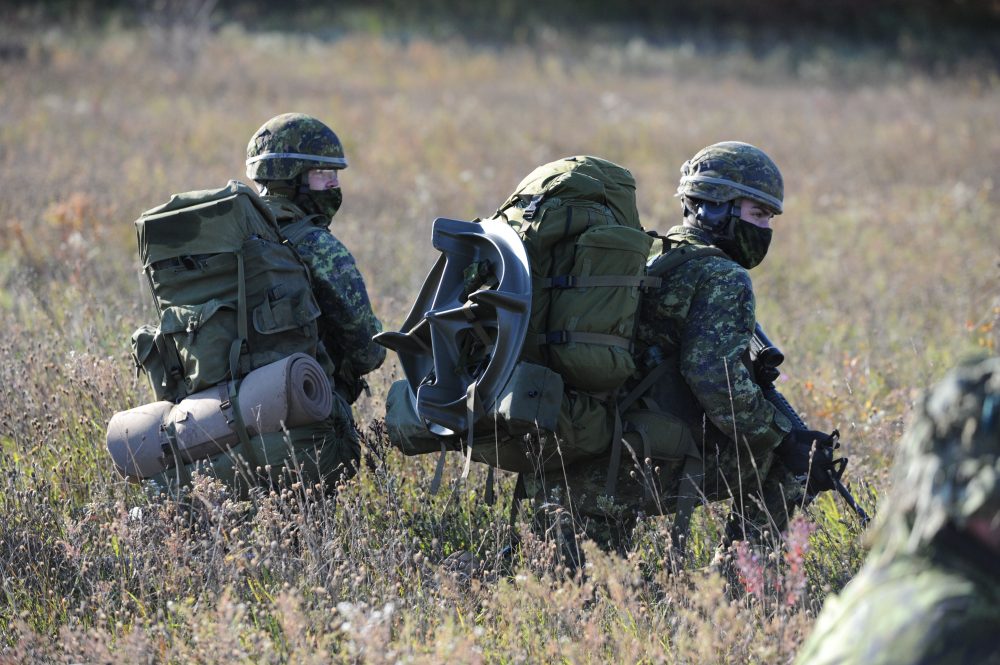
How the Armed Forces faced an invisible enemy
November 11, 2020
By
Kelli McRobert
Canadian military finding new ways to serve through COVID-19

Through the COVID-19 pandemic, the Canadian Armed Forces has been called into duty when others were asked to stand down. (Photo by Andrew McLaughlin, Public Affairs Officer, 31 Canadian Brigade Group)
In March of this year, Canada’s COVID-19 lockdown began.
To my knowledge as a Brigade Safety Officer, it was the first time that all of Canada had to shut down to fight an invisible enemy — COVID-19.
We had had a previous taste of this virus during the SARS outbreak, but it seemed that 2020 would be a year of change.
The change evolved, slowly at first, as provinces began to restrict movements and were assessing levels of risk.
The military began isolating members to ensure that Armed Forces members could be provided — if needed — to continue to support the efforts of floods, fires, and long-term care facilities.
Advertisement
We also moved into a mobile support posture of sorts, where office administration shifted to telework and meetings became virtual so we could continue to engage our members, train and plan for any potential call-outs or militant restrictions that may need to be enforced. This was an unknown mission with no firm end date in sight.
As the saying goes: “Life goes on.” We needed to plan for worst-case scenarios and hope for the best.
Serving through COVID-19
Business resumption plans were established and put into place as we planned out the various stages based on provincial guidelines — this was a challenge as our members reside coast to coast and we were still trying to recruit, train and support members of the forces, while keeping employees safe, protected and, in some cases, isolated to prevent the spread, knowing that carriers could be asymptomatic.
In my role with the Department of National Defence, I get the opportunity to learn and finetune my craft with a diversity unseen by many other businesses.
We have the challenge of a distinct workforce and one that is called to duty when others are asked to stand down.
During the pandemic, we needed to ensure we had healthy members who had sufficient personal protective equipment (PPE), while balancing the purchasing of the PPE from our own sources to not drain the local supplies.
At the onset of the virus, we needed to ensure that our workers were being vigilant and not contributing to the spread of the virus.
This meant oftentimes that members were removed from their homes and isolated for up to 14 days to create their own “working bubble” and we had to consider the mental health of the workers who would be facing death, uncertainty and the struggles that come with isolation and the loss of life when caring for those in crisis.
Safety – the army way
As with other essential services, such as police or fire, the military are expected to continue, no matter what.
As safety officers, we had to review all aspects of members’ training, home life, work life and field exercises.
We had to contact subject matter experts to weigh the risks of a variety of potential activities such as confined quarters (tents in the field), attending an in-person formal training exercise, protocols for contact tracing, and the management of returning some of our workers to their workplace, when possible.
We considered ergonomics, lighting, access to IT and performing virtual inspections to ensure compliance and the safety of our establishments.
It has been a time to think outside the box and move forward with lessons learned, while relying on best practices of others to support our mission while keeping workers safe both physically and mentally.
Keep moving forward
As we continue to navigate through these uncertain times, we are better equipped with knowledge of what worked and what did not work from the first shutdown.
We have modified some of our procedures to help better support workers at home. And we have come up with techniques to mitigate some of the risks, while still allowing training to occur to keep our members strong, resilient, and prepared to battle foes — both seen and unseen.
2020 will go down in history as perhaps the start of something new, a shift in the way we think, act, and react to challenging global situations.
Are we prepared for this? Only time will tell as we assess risks, re-align strategies, and build our defences (physically, mentally, digitally) to ensure a strong and resilient workforce that can bend with the evolving changes — and hopefully not break.
Kelli McRobert, BEd., CRSP, CHSC, CES, is a 33 Canadian Brigade Group Safety Officer with the Department of National Defence in Ontario.